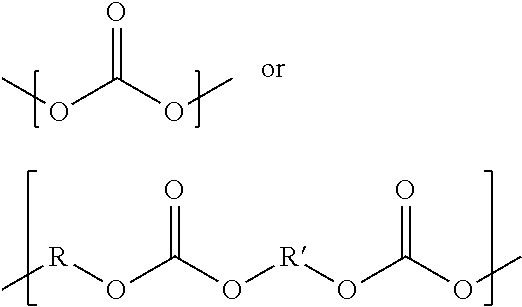Photorefractive composition comprising electrolytes in a photorefractive layer and method of making thereof
a photorefractive layer and electrolyte technology, applied in the field of photorefractive composition and photorefractive device, can solve the problems of complex synthesis of tpd acrylate monomer, difficult to obtain, and inability to readily commercialize tpd acrylate monomer, so as to improve grating response and grating decay time, and reduce the grating response time and/or the grating decay time
- Summary
- Abstract
- Description
- Claims
- Application Information
AI Technical Summary
Benefits of technology
Problems solved by technology
Method used
Image
Examples
example 1
Preparation of Photorefractive Devices
[0083]A photorefractive composition testing sample was prepared comprising two ITO-coated glass electrodes, and a photorefractive layer. The components of the photorefractive composition were approximately as follows:
(i) Matrix polymer APC:~33 wt %(ii) Prepared chromophore of 7F-DCST~33 wt %(iii) Ethyl carbazole plasticizer~33 wt %(iv) Electrolyte 10-methyl-9-phenylacridiniumlisted in Table 1perchlorate (MPP)
[0084]To prepare the composition, the components listed above were dissolved in dichloromethane with stiffing and then dripped onto glass plates at 60° C. using a filtered glass syringe. The composites were then heated to 60° C. for five minutes and then vacuumed for five more minutes. The composites were then heated to 150° C. for five minutes and then vacuumed for 30 seconds. The composites were then scrapped and cut into chunks.
[0085]Small portions of this chunk were taken off and sandwiched between indium tin oxide (ITO) coated glass pla...
example 2-9
[0088]A photorefractive device was obtained in the same manner as in Example 1 except that the electrolyte doping percentage and photorefractive layer thickness were different. The amount of electrolyte and photorefractive layer thicknesses are provided in Table 1.
examples 10-11
[0092]A photorefractive device was obtained in the same manner as in Example 1 except that the polymer in the photorefractive layer is PMMA. The electrolyte doping percentage and photorefractive layer thicknesses are provided in Table 2.
PUM
| Property | Measurement | Unit |
|---|---|---|
| wavelength | aaaaa | aaaaa |
| grating response time | aaaaa | aaaaa |
| grating response time | aaaaa | aaaaa |
Abstract
Description
Claims
Application Information
 Login to View More
Login to View More - R&D
- Intellectual Property
- Life Sciences
- Materials
- Tech Scout
- Unparalleled Data Quality
- Higher Quality Content
- 60% Fewer Hallucinations
Browse by: Latest US Patents, China's latest patents, Technical Efficacy Thesaurus, Application Domain, Technology Topic, Popular Technical Reports.
© 2025 PatSnap. All rights reserved.Legal|Privacy policy|Modern Slavery Act Transparency Statement|Sitemap|About US| Contact US: help@patsnap.com



